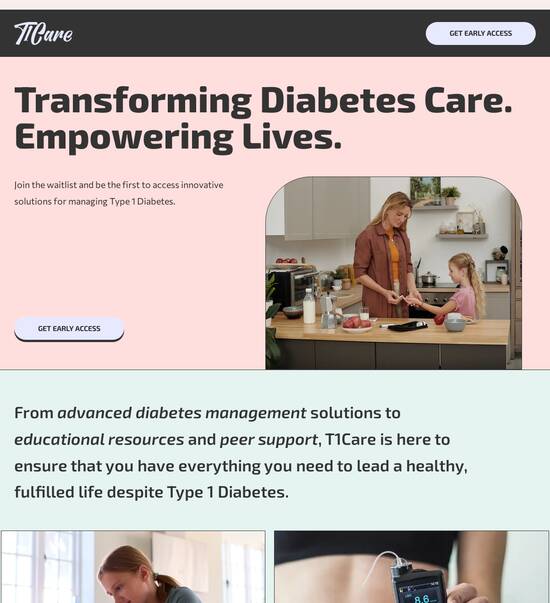
Pricing page template for Game designers
Explore Similar TemplatesAbout template
Master your online marketing with this builder for pricing page template for Game designers. Try more tools to create an immaculate landing page.
Recommended templates

Easy to build without coding
With the intuitive drag-and-drop builder, anyone on your team can create high-converting pages without any knowledge of code or design. Make enhancements to your landing page with custom widgets using Javascript, HTML/CSS, or third-party scripts.

Multiple layouts for any industry and goal
Select from 500+ landing page layouts built to boost conversions across industry-specific scenarios. Customize them by adjusting fonts, adding images, and generating on-brand content with the AI assistant. Quickly scale with Instablocks® and Global Blocks that you can save, reuse, and update globally.

Loads fast and looks polished on any device
Every template is responsive, which means they present professionally on any device and load blazingly fast with our Thor Render Engine. You can also power them up with Google AMP technology to deliver an unparalleled mobile experience and drive higher conversions.

Robust analytics & experimentation
Get real-time updates and reporting across all your devices, showing the number of visitors, conversions, cost-per-visitor, and cost-per-lead. Launch AI-powered experiments, run A/B tests, and use heatmaps to analyze user behavior, then optimize your landing page to maximize conversions.







Easy to build without coding
With the intuitive drag-and-drop builder, anyone on your team can create high-converting pages without any knowledge of code or design. Make enhancements to your landing page with custom widgets using Javascript, HTML/CSS, or third-party scripts.
Multiple layouts for any industry and goal
Select from 500+ landing page layouts built to boost conversions across industry-specific scenarios. Customize them by adjusting fonts, adding images, and generating on-brand content with the AI assistant. Quickly scale with Instablocks® and Global Blocks that you can save, reuse, and update globally.
Loads fast and looks polished on any device
Every template is responsive, which means they present professionally on any device and load blazingly fast with our Thor Render Engine.
Robust analytics & experimentation
Get real-time updates and reporting across all your devices, showing the number of visitors, conversions, cost-per-visitor, and cost-per-lead. Launch AI-powered experiments, run A/B tests, and use heatmaps to analyze user behavior, then optimize your landing page to maximize conversions.
All the features you need to build lead-generating landing pages
Explore more featuresLearn how to build top-performing landing pages for any goal
FAQs
Leading the way in building high-performing landing pages





A comprehensive guide to optimizing your landing pages with Instapage
Designing effective landing pages is crucial for marketers aiming to convert traffic into leads. Instapage provides the most powerful landing page and conversion rate optimization (CRO) platform, equipping marketers with all the tools necessary to enhance their digital campaigns. This guide will walk you through a step-by-step process on using Instapage to create high-converting landing pages, catering to various industries such as tech, education, and financial services.
Understanding the importance of landing pages
Landing pages serve as dedicated web pages designed to prompt users to take a specific action. They are essential for capturing lead information and guiding potential customers through the sales funnel. An optimized landing page can significantly impact conversion rates, making it imperative to implement best practices in design and functionality.
- Conversion-focused templates: Instapage offers over 100 templates optimized for performance to save you time and improve your campaign's efficiency.
- Customizable designs: Users can tailor landing pages to align with brand identity while incorporating necessary lead generation elements.
- Built-in optimization tools: Utilize A/B testing and heatmap analytics to tweak and enhance your landing page's effectiveness continuously.
Step 1: Choosing the right template
Start by selecting a template that resonates with your target audience and campaign goals. Instapage's intuitive builder allows you to filter templates based on your industry, making it easy to find a suitable design.
- Select from various industries: Choose templates that cater to business services, education, or tech, ensuring your page meets audience expectations.
- Utilize high-converting elements: Pick templates that feature proven lead gen strategies, such as compelling headlines and strong calls-to-action.
- Ensure mobile responsiveness: With a significant amount of traffic coming from mobile devices, opt for templates that perform well across all platforms.
Step 2: Customizing your landing page
Once you have chosen a template, it’s time to customize it. Instapage allows for real-time editing, enabling you to make adjustments quickly to your content and layout.
- Incorporate dynamic text replacement: Use personalized content that speaks directly to specific audience segments for increased engagement.
- Integrate your branding: Align colors, fonts, and imagery to maintain consistency with your overall brand identity.
- Add interactive elements: Utilize forms, buttons, and callouts to encourage user interaction and drive conversions.
Step 3: Optimizing for conversions
After crafting your landing page, it’s crucial to optimize it. This includes conducting experiments and analyzing user behavior.
- Use A/B tests: Experiment with different headlines, layouts, and CTAs to identify the most effective combinations.
- Analyze heatmaps: Instapage provides insights into where users click and spend their time, allowing you to refine your design based on actual user behavior.
- Monitor key performance metrics: Utilize analytics to track conversion rates, bounce rates, and overall performance to continually enhance your landing page.
In conclusion, utilizing Instapage can immensely streamline the process of creating optimized landing pages that drive conversions. By leveraging its powerful features and insights, marketers can create targeted, high-converting landing pages tailored to their audience's needs.
Start transforming your marketing campaigns today. Sign up for Instapage and unlock unparalleled features that will maximize your digital marketing ROI.
People also ask about Pricing page template for Game designers
The essential guide to crafting an effective pricing page template for game designers
Understanding the role of a pricing page in game design
The pricing page serves as a pivotal point in a game designer's marketing strategy. It’s where potential customers convert into paying users. In an industry filled with competition, an effective pricing page can make or break the chances of success. This page not only displays pricing tiers and options but also serves as an introduction to the perceived value of the game or service offered. An enticing pricing page can engage users and encourage them to explore the game further.
Furthermore, the pricing page impacts user attraction and conversion rates by presenting clear choices and transparent pricing. A well-crafted pricing strategy helps to set the tone for pricing in the gaming market, building trust and confidence among potential buyers. Ultimately, the efficacy of a pricing page is measured in its ability to convert visits into purchases, making it a vital component of any marketing plan for game designers.
Key components of a game designer's pricing page
There are several essential elements that should be included on a pricing page. The most critical component is the pricing table, which provides a visual representation of various pricing options available to users. This table should clearly distinguish between free and paid options, making it easier for users to understand the benefits of each tier.
Additionally, feature comparisons across pricing plans are crucial. Users should be able to see at a glance what features are included in each tier, allowing for an informed decision. Another important inclusion on your pricing page is lead generation elements, such as sign-up forms and lead magnets, to capture interest. You can also emphasize unique selling points for each tier with clear callouts that articulate the value propositions, making it easy for potential customers to select the right plan.
Pricing table with clear tier distinctions.
Feature comparisons for each pricing plan.
Lead generation elements such as sign-up forms.
Highlighting unique selling points clearly.
The creative UI: enhancing user experience
UI design plays a significant role in enhancing user experience on a pricing page. Essential design principles should include visual hierarchy that guides the user's eye through the content effectively. A well-structured layout can make complex information digestible, ensuring that users don’t feel overwhelmed. An optimal use of whitespace can create a cleaner look and focus attention on key information, making the page more inviting to navigate.
Color psychology is another powerful tool in UI design. Selecting colors that resonate with your target audience can influence user perception and decisions. For instance, vibrant colors might attract younger gamers, while muted palettes may appeal to older demographics. Understanding the emotional impact colors have on users is essential when selecting a palette for your pricing page.
Refreshing the pricing structure: adapting to market trends
It's essential to periodically review and update the pricing strategy to align with market trends. Game designers should keep a pulse on emerging technologies, changes in consumer behavior, and competitor pricing strategies. Regular analysis of these factors can reveal insights that suggest necessary adjustments in pricing to stay competitive and appealing to users.
Feedback from users can also play a vital role in refining pricing options. By listening to user experiences and suggestions, designers can adapt their offerings to meet market demands more accurately. This flexibility can lead to sustained interest in the game and its features, helping to convert visitors into loyal customers.
Targeting diverse user demographics
Understanding the diversity among game users is vital when crafting pricing plans. Each demographic has different preferences, so designers should tailor pricing structures to cater to various segments. For example, a gaming platform might want to consider the differing needs of casual vs. hardcore gamers. Engaging content that addresses these diverse interests enhances the overall experience.
Creating user personas based on computer users’ behavior can also help developers understand their audience better. Identifying these personas allows for more personalized marketing efforts and pricing strategies that appeal to specific user habits and preferences, ultimately driving conversions.
Optimizing performance for website users
Analyzing website performance metrics is an ongoing task for game developers and marketers. It’s important to track how users interact with the pricing page. Understanding which elements draw interest and where users drop off can provide critical insights into user behavior. Utilizing tools for A/B testing can allow designers to try different layouts and content to determine which performs best.
This performance data forms the backbone of strategic adjustments, allowing designers to hone the user experience continually. By analyzing user interactions, game developers can refine their pricing pages to minimize friction and maximize engagement and conversion.
Best practices for marketing strategies around pricing pages
Integrating pricing pages into the overall marketing funnel is crucial for the success of any game design. This means considering elements like email marketing that directs users to the pricing page, or using social media to generate buzz around new offerings. Creating anticipation around game launches can also increase the effectiveness of pricing strategies, such as teasing special introductory prices.
Additionally, leveraging social proof through testimonials and user reviews can significantly drive conversions. When potential customers see positive feedback from others who have purchased or experienced the game, it builds trust and encourages them to take action.
Examples of effective pricing page templates in the gaming industry
Examining case studies from successful game companies can illuminate what works in creating compelling pricing pages. For instance, several well-known gaming companies effectively employ clean layouts, strong visual elements, and straightforward pricing structures to enhance user experiences. The inclusion of comparative pricing strategies alongside highlighted features also helps prospective customers feel confident in their purchasing decisions.
Features that make these examples stand out often include clear calls to action, easy navigation, and visuals that align with the game's theme. These elements can significantly influence consumer engagement and inspire action, ultimately driving success and revenue for the game developer.
Balancing design and accessibility
Accessibility must be a core consideration when designing pricing pages. This involves ensuring the layout is user-friendly and that typography is legible across various devices. Attention to contrast, color choices, and responsive design can influence how all users experience the pricing page.
Employing inclusive design techniques enhances overall user experience and ensures all website visitors can engage with the content effectively. This commitment to accessibility not only broadens the potential customer base but also reflects positively on the brand's credibility.
Leveraging analytics for continuous improvement
Identifying key performance indicators (KPIs) specific to pricing pages is essential for ongoing improvement. Metrics such as conversion rates, average time on page, and user drop-off points provide valuable insights into how the pricing structure is performing.
Utilizing analytics tools allows designers to gather actionable insights based on user behavior, informing future design adjustments and marketing strategies. Continuous testing and refinement can help optimize the pricing page to foster better engagement and improved conversion rates.
The future of pricing pages in game design
As the gaming industry evolves, so too will the design of pricing pages. Trends may include more dynamic content tailored to user behavior and advances in technology that improve user interactivity and engagement. Moreover, as competition grows, the need for unique and appealing pricing models will likely influence future designs.
Predicted innovations in user interface and experience include enhanced visual storytelling on pricing pages, integration with social channels, and personalized user experiences that adjust based on user preferences. Embracing these trends will be crucial for developers looking to remain competitive.
Integrating feedback loops for sustained growth
Creating consistent channels for customer feedback is vital to maintaining a successful pricing strategy. Surveys, user reviews, and direct communication with customers can foster a culture of constant improvement. By adapting strategies based on user suggestions, designers can remain relevant and responsive to evolving user needs.
Establishing feedback loops that encourage honest communication can enable quicker pivots in response to user concerns, ultimately supporting sustained growth. This adaptive approach can lead to a more engaging user experience on pricing pages and improved overall satisfaction with the displayed game offerings.
Final thoughts on crafting interactive and engaging pricing pages
In conclusion, crafting a compelling pricing page for game designers involves a blend of engaging design, strategic thinking, and an understanding of technology. It requires constant reflection on user preferences and industry trends, ensuring the page remains relevant and effective. Successful pricing pages will not only display pricing but will also enhance the overall user journey, contributing to increased conversions and user satisfaction.
Ultimately, optimizing pricing pages is an ongoing journey that adapts to meet the evolving demands of game audiences. By focusing on the key components discussed in this guide, game designers can create effective pricing pages that not only attract but also retain users, driving long-term success in their gaming endeavors.
Ready to skyrocket conversions?
Supercharge your ad campaigns with high-performing landing pages
Get started














